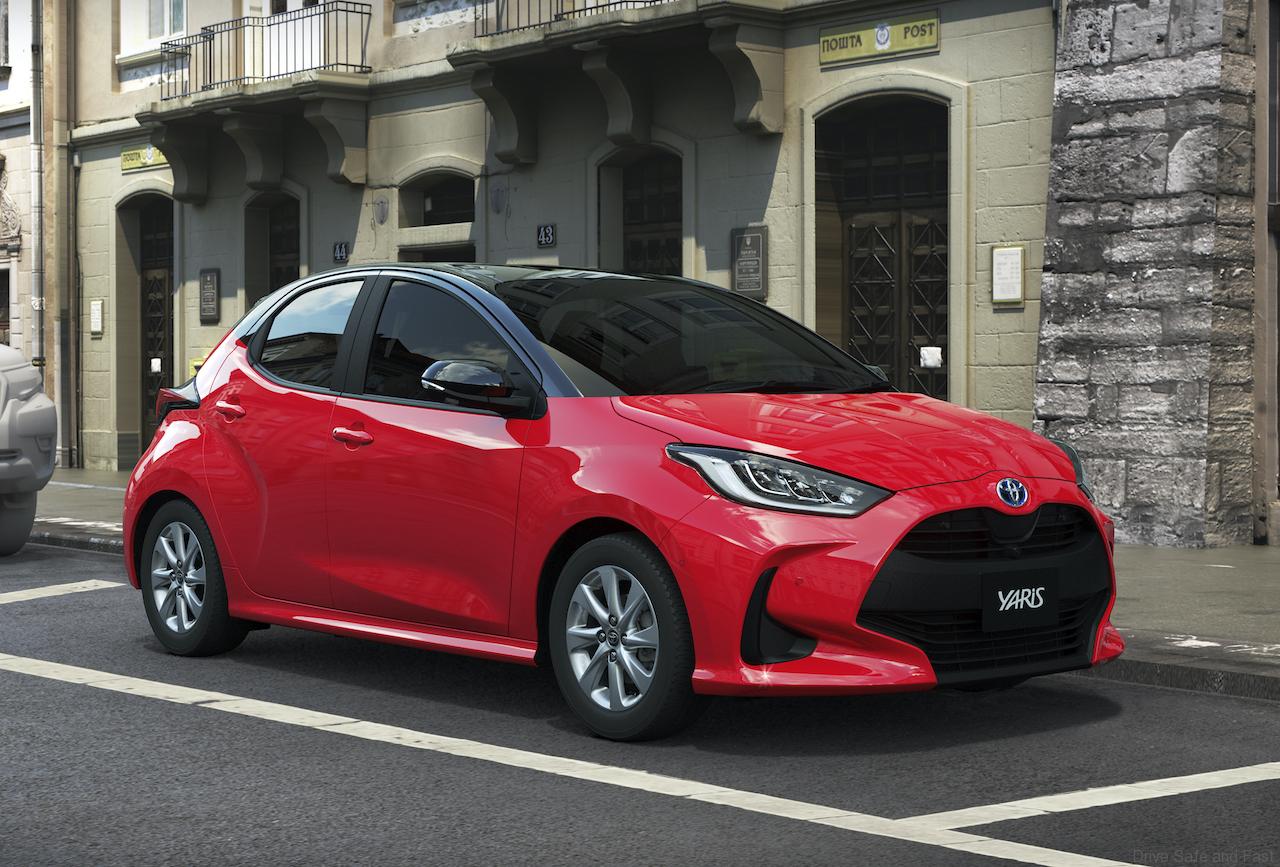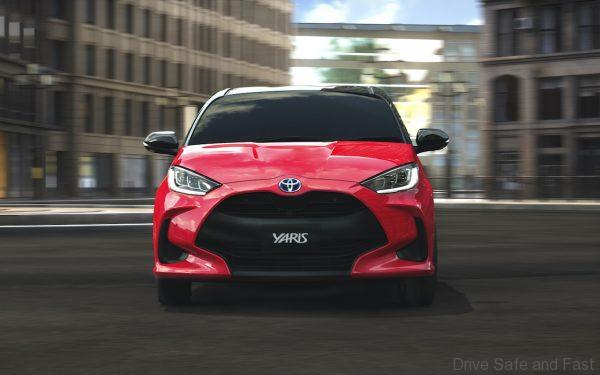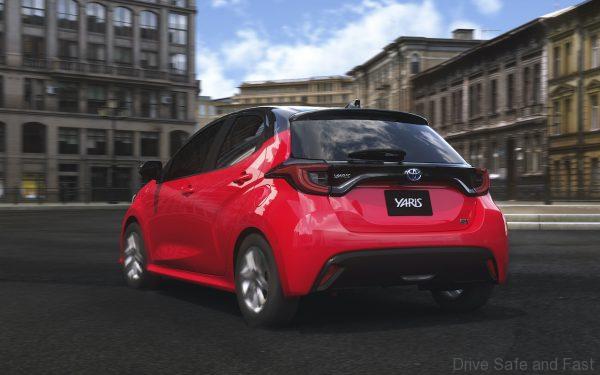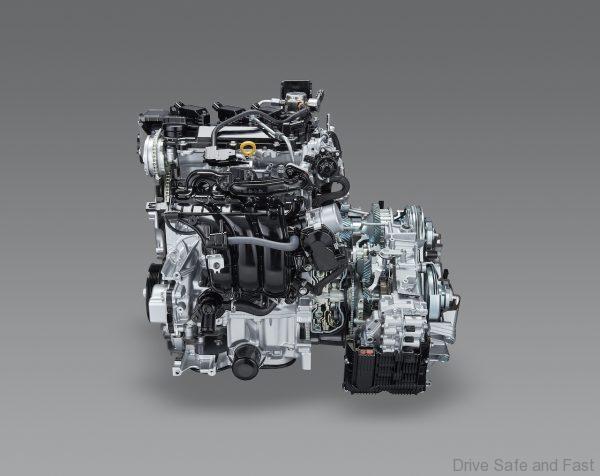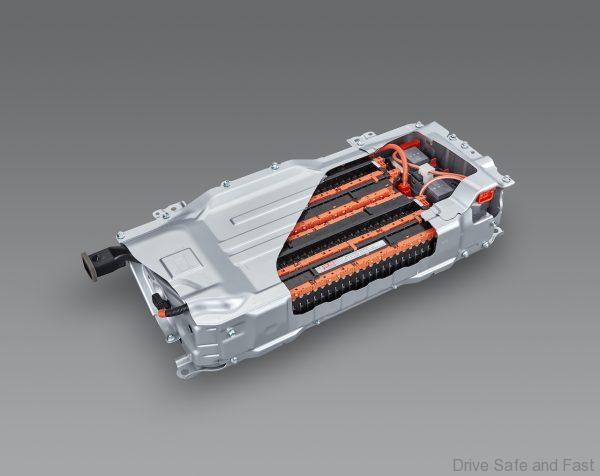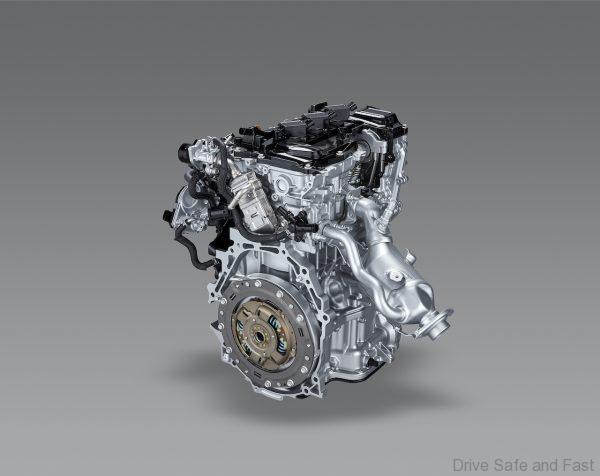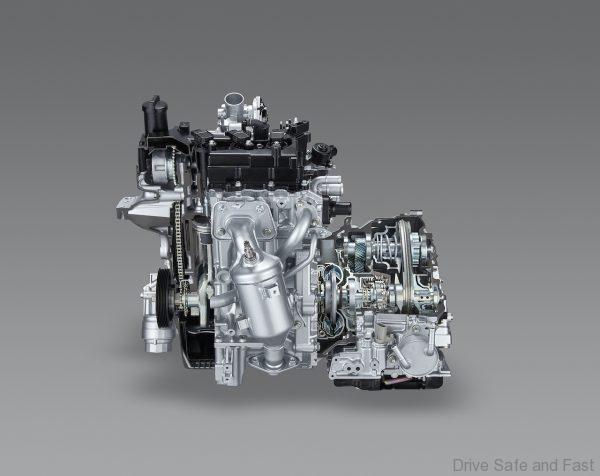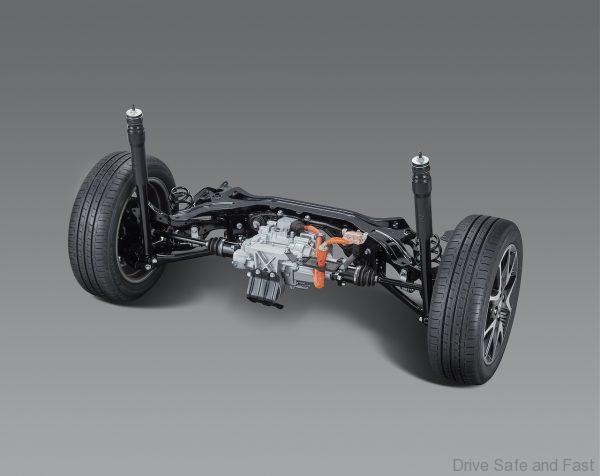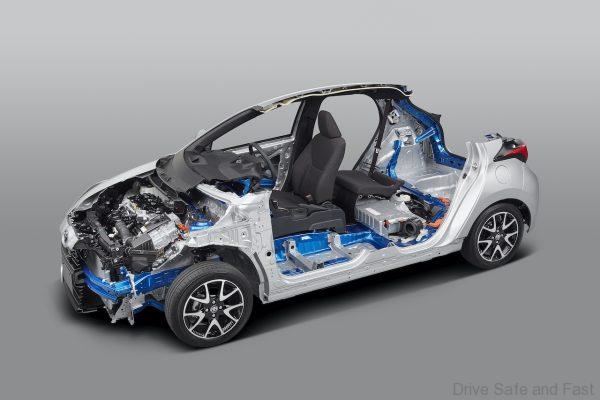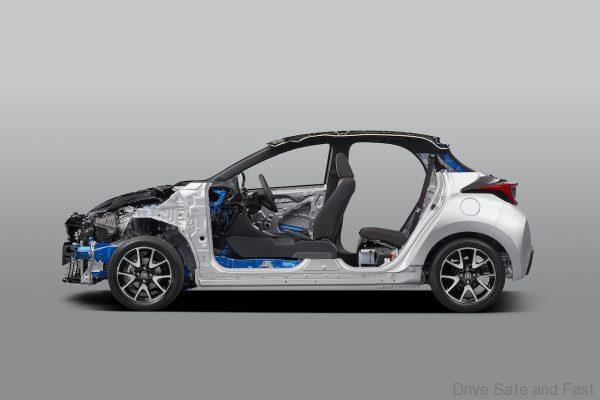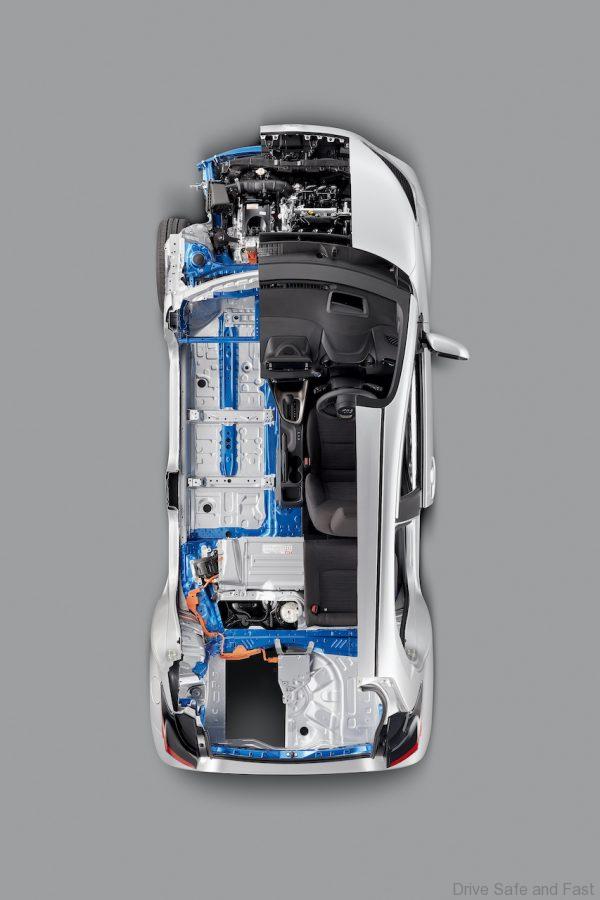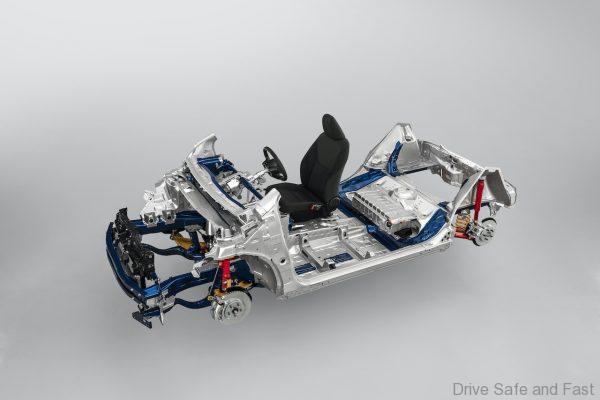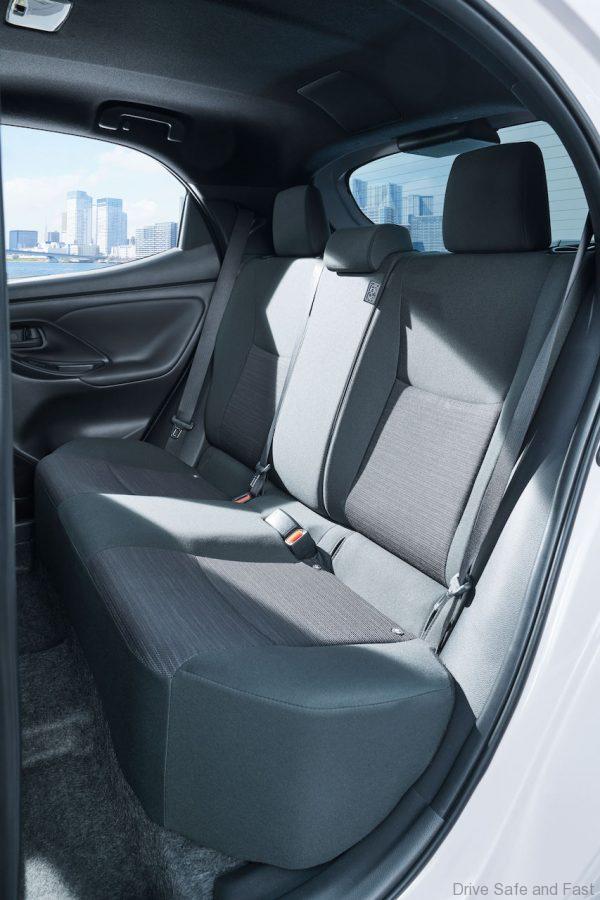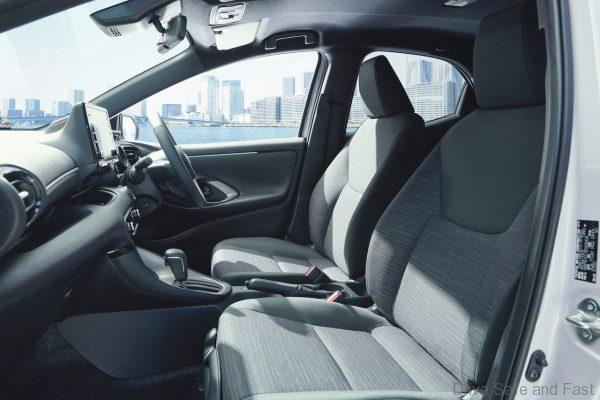Toyota have revealed an all-new Yaris ahead of its public debut at the 2019 Tokyo Motor Show. This new Yaris will go on sale in Japan in February 2020. It adopts loads of cutting edge Toyota technology, such as a compact version of the TNGA platform, a Dynamic Force Engine, a new-generation hybrid system, Advance Park, Toyota Safety Sense and more.
Here are more details.
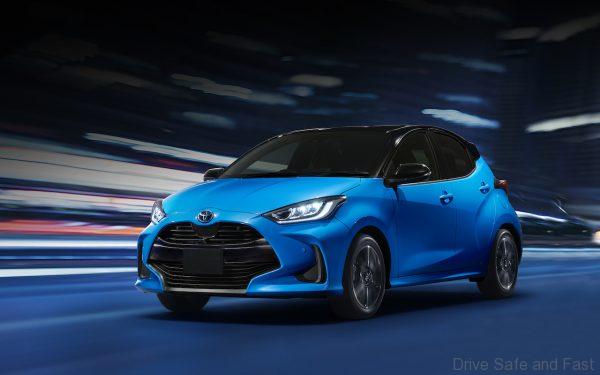
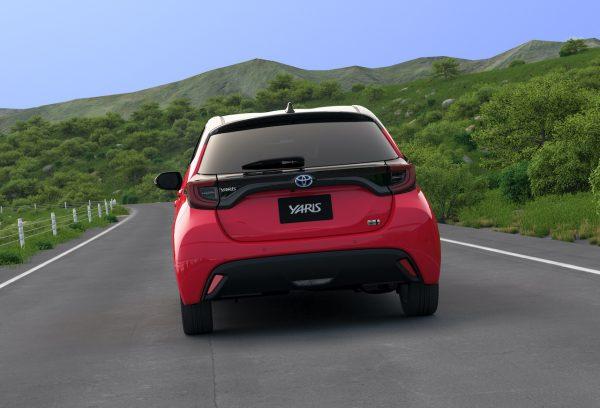
Drivetrain Options
There are four variations on the new Yaris, three of which use the newly developed 1.5-litre 3-cylinder Dynamic Force Engine.
- 1.5L Dynamic Force Engine + Direct Shift-CVT
- 1.5L Dynamic Force Engine with new-generation Hybrid System with E-Four Electric 4-wheel drive
- 1.5L Dynamic Force Engine with 6-speed manual
- 1.0L 1KR-FE 3-cylinder with a lightweight CVT.

1.5L Dynamic Force Toyota with Direct Shift CVT 
New Lithium Ion battery on hybrid 
1.5L Dynamic Force 
1.0L engine 
Hybrid rear axle with E-Four
TNGA Platform
The Yaris is the first car to adopt the TNGA-B platform, which is 50kg lighter, 30% more rigid and has a 15mm lower centre of gravity. The platform utilises MacPherson Struts on the front and in the rear it is fitted with either a torsion beam on the front-wheel-drive models and two-link double wishbone suspension on four-wheel drive and E-Four Hybrid models.
Other Huge Features
While the Yaris continues to be a 5-door hatchback in the compact B-segment, Toyota are throwing loads of technology its way.
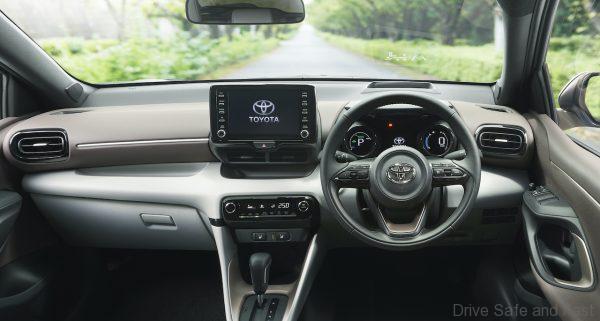
- Toyota Turn Tilt Seats
- Advanced Park
- Toyota Safety Sense (Dynamic Radar Cruise Control, Lane Tracing Assist, Automatic High Beam, Road Sign Assist)
- High mounted Display Audio
- Heads Up Display
- Home Charging on Hybrid models (in blackout situations)
- Dual Digital TFT instrument cluster
It is unlikely this all-new Toyota Yaris will find its way to Malaysia through official channels as the Yaris (XP150) on just began production at the Bukit Raja plant this year.

But if you’re interested in this new car, check out the details in the press release below.
PRESS RELEASE
The first-generation Yaris was created in 1999 as a car that would serve as the global standard for compact cars by enlisting the full portfolio of Toyota’s technological prowess. Toyota re-designed the platform and all major components, including the engine, transmission, and suspension to achieve generous cabin space and outstanding basic performance in a minimum size.
The new Yaris has been developed in pursuit of new value sought in next-generation compact cars. The new Yaris is a new-generation compact car that adopts the TNGA*1 platform, on which Toyota will base its compact cars for developed countries in the future, and features components built entirely from the ground up, including the engine, Hybrid System, transmission, and suspension. In addition to the light yet highly rigid body and low center of gravity, the Yaris is offered with four different powertrains to deliver agility, superior comfort, and smooth and direct acceleration
- The newly developed 1.5-liter inline three-cylinder Dynamic Force Engine and Direct Shift-CVT
- The 1.5-liter Dynamic Force Engine with New-generation Hybrid System
- The 1.5-liter Dynamic Force Engine with 6-speed manual
- An improved 1.0-liter engine with a compact and lightweight CVT
Drivers will be able to experience the pleasure of a brisk ride.
In addition to pursuing Toyota’s ongoing goal of developing the world’s highest level of fuel efficiency for a hybrid vehicle, the new Yaris is offered with E-Four (electric four-wheel drive system), a first for a Toyota compact car. Toyota is among the first to adopt an array of advanced features that defy the common hierarchy based on car size, such as Advanced Park*2, Toyota’s advanced parking support system (a first for a Toyota vehicle); the latest Toyota Safety Sense, which has been expanded to detect oncoming cars when turning right at an intersection and pedestrians crossing the street when turning right or left; Turn Tilt Seats*2 (equipped by Toyota for the first time) which facilitate entering and exiting the vehicle; and Display Audio (standard on all models), which can connect with smartphones.
An accessory power outlet (1,500 W) is available for the hybrid version of the cars. With the accessory, electricity from the vehicle can be used to power electrical devices and appliances using the same type of electrical outlets found at home. Additionally, the vehicle can serve as an emergency power generator in cases such as blackouts.
Chief Engineer Yasunori Suezawa, in charge of development of the new Yaris, explained, “This marks the 20th year since the first Yaris debuted, so we wanted to build a new-generation compact car that goes far beyond customers’ preconceptions about class by building on the strengths of the Yaris as a compact car while revamping the platform, powertrain, and all other components. Compact cars are driven by many people, so offering a pleasurable drive was a priority, but it also prompted us to use the Yaris as the starting point of cars with the world’s highest level of fuel efficiency and secure safety technology.”
Vehicle Outline
A new-generation compact car with the platform, engine, transmission, Hybrid System, and suspension all built from the ground up.
Platform
The new model Yaris is Toyota’s first car to adopt the TNGA*1 platform (GA-B) for compact cars, which features a body developed to be lightweight and highly rigid with a low center of gravity. The platform achieves both superior handling stability and a high-quality ride by shedding 50 kg in vehicle weight*7 compared to the conventional model, increasing torsional rigidity by at least 30 percent, and lowering the center of gravity by 15 mm. It also delivers driving performance beyond its class by being agile yet Confident and Natural (the vehicle remains stable while driving yet responds naturally to the driver’s intentions).
Eyes On the Road Concept
All models come standard with a high-mounted Display Audio (DA) and Head Up Display*2 (HUD) to reduce driver eye movement. The layout allows the driver to concentrate on driving and reduces fatigue.
Engine
- Toyota newly developed a 1.5-liter inline three-cylinder Dynamic Force Engine based on the TNGA design philosophy. This engine uses high speed combustion technology, such as a longer stroke and expanded valve angle to achieve both low fuel consumption and high output.
- Toyota also enhanced the 1.0-liter inline three-cylinder engine through various improvements that include increased tumble flow, higher EGR (exhaust gas recirculation) rate, and reduced friction to achieve nimble driving and low fuel consumption.
Hybrid System
The new-generation 1.5-liter Hybrid System (adopted by Toyota for the first time) achieves greater fuel efficiency by enhancing the efficiency of the entire system and by adopting a dedicated engine designed for the Hybrid System and the other newly developed hybrid units. In addition to achieving the world’s highest level of fuel efficiency for a hybrid vehicle, acceleration has also been enhanced to in pursuit of both fuel efficiency and performance. E-Four is being offered on a Toyota compact car for the first time.
Transmission
- The transmission features a newly developed Direct Shift-CVT unit with a launch gear adapted to the new 1.5-liter engine. This greatly improves transmission efficiency at low speeds compared to the existing CVT and achieves direct and smooth driving according to accelerator operation and excellent fuel efficiency performance.
- Equipped with a newly developed CVT for the 1.0-liter engine. This CVT is smaller and lighter than previous models and has improved fuel efficiency performance.
Suspension
- The suspension uses MacPherson Struts on the front, providing agile and smooth motion.
- The rear uses a torsion beam suspension for both handling stability and ride comfort (front-wheel drive). The Four-wheel drive*5 / E-Four adopts a two-link double wishbone suspension.
The condensed, clutter-free design looks ready to take off at a moment’s notice, and the interior expresses the comfortable atmosphere of a higher class cabin that allows the driver to concentrate on driving.
Exterior Design
- The design concept is “B-Dash!” Be bold, brisk, and beautiful. The image is to dash off with nimble acceleration like a bullet. Toyota sought to create an exterior design that packs an abundance of power to make the car appear as if it’s ready to take off at a moment’s notice. The clutter-free cabin and compact shape that extends from the center of the body to the front and rear wheels express a design that suggests an active driving experience.
- The sharp styling of the headlights gives the face a fearless expression. The rear was designed to make heads turn by integrating the rear window and rear-combination taillights into a new three-dimensional form.
Exterior Color
Offered in 12 colors including the newly developed Ice Pink Metallic and Coral Crystal Shine. Also available in a total of six two-tone color schemes paired with either a black or white roof color.
Interior Design
The clutter-free interior provides a spacious and comfortable atmosphere that allows the driver to concentrate on driving. The thin cross section of the instrument panel gives it a wide impression which, together with the small diameter of the steering wheel, makes the cabin feel more spacious and sporty.
Various features were adopted to express the quality of a higher class interior, including hood-less dual digital TFT meters*2 (adopted by Toyota for the first time) and a soft instrument panel*2, as well as a wider console and increased storage space.
Advanced features for safety, security, comfort, and convenience
Comes standard*3 with Toyota Safety Sense, Toyota’s latest active safety package
- The pre-collision safety system detects pedestrians during the day and night and cyclists during the day to help prevent collisions and mitigate damage. The sensing system has been expanded to prevent accidents at intersections by detecting oncoming cars when turning right and pedestrians crossing the street when turning right or left (adopted by Toyota for the first time).
Toyota also added Low Speed Acceleration Control*8 (adopted by Toyota for the first time) to support the prevention of collisions caused by pedal misapplication at time of reduced speed. This uses millimeter-wave radar and a mono camera to recognize bicycle riders and pedestrians immediately in front of the car. This control helps prevent collisions and mitigate damage by suppressing the engine output or by lightly applying the brakes to suppress acceleration if there is an object in front of the car and the accelerator pedal is depressed with excessive force when starting from a standstill or during low-speed operation.
- Dynamic Radar Cruise Control with full-speed range that supports driving behind another car
- Lane Tracing Assist (LTA*9 that enhances steering so cars can remain centered in the same lane when using the radar cruise control
- Automatic High Beam (AHB) that changes between high beam and low beam headlights
- Road Sign Assist (RSA) that displays road signs recognized by the camera on the display so that drivers do not miss them
Secondary Collision Brake*10
The new Yaris is equipped with a Secondary Collision Brake, which contributes to mitigating the damage caused by secondary collisions. The Secondary Collision Brake and the brake lights are automatically activated if the SRS air bag sensor detects a collision and activates the air bags. This decelerates the vehicle to mitigate damage caused by secondary collisions.
Advanced Park*2 (Advanced Parking Support System, equipped on a Toyota vehicle for the first time)
- For the first time, Toyota is introducing Advanced Park*2, which represents the cutting edge of Toyota’s Advanced Parking Support System and is based on Toyota’s automation concept*11 of having the car and driver act as partners.
- This system supports parking operations by controlling not just the steering wheel, but also the accelerator and brakes (the driver needs only to operate the shift lever according to instructions). The system alerts the driver with audible warnings and applies the brakes to help avoid minor collisions by using cameras and ultrasonic sensors to monitor the vicinity of the car.
- By setting the parking spot in advance, the system can also park in spots without white lines (a world first*12)
Easy Return Seat*2 (equipped on a Toyota vehicle for the first time)
This mechanism memorizes the driver’s seat position using manual operation. Passengers can enjoy a comfortable ride, including in the rear seats, and let the Easy Return Seat function do the work when entering and exiting seats.
Turn Tilt Seats*2 (equipped on a Toyota vehicle for the first time)
This mechanism makes it easy for the driver and front passenger enter and exit the car by rotating the seat and tilting it. This facilitates entering and exiting the vehicle by passengers wearing a skirt or kimono and supports those with back pain or low muscle strength.
Accessory power outlet
An accessory power outlet (1,500 W) is available for the hybrid version of the cars. With the accessory, electricity from the vehicle can be used to power electrical devices and appliances using the same type of electrical outlets found at home. Additionally, the vehicle can serve as an emergency power generator in cases such as blackouts.
Latest Connected Services
- All models come equipped with Display Audio (DA), which can connect with smartphones, and DCM*13 as standard features. This allows a smartphone to be used with various functions, and allows all customers to use connected services*14. Customers who prefer conventional on-board navigation systems can choose either the Entry Navigation Kit or T-Connect Navigation Kit.
- Through SmartDeviceLinkTM*15 (SDL), smartphones can connect with Bluetooth®*16 or a USB cable for use of navigation applications including TC smartphone navigation and LINE car navigation*17, as well as music and radio applications on DA. Voice recognition enables destination-setting, sending and receiving LINE messages, music playback, and other functions, improving convenience.
- Apple CarPlay®*18 and Android AutoTM*19 can use maps, phone calls, messaging, and music applications through DA by connecting smartphones with a USB cable (option includes TV; T-Connect contract required at time of signing contract).
- HELPNET is one of the basic T-Connect services that provides drivers with assistance in the event of an accident or sudden illness. Pressing the HELPNET button connects to a dedicated operator who can promptly arrange for an emergency vehicle based on the vehicle’s location. It also supports D-Call Net®*20, which makes decisions on whether to call for a medical helicopter by automatically connecting with an operator if the air bags are activated.
- Customers can choose the services they need from among optional services, including vehicle location tracking and operator services, for a monthly or yearly subscription fee.

